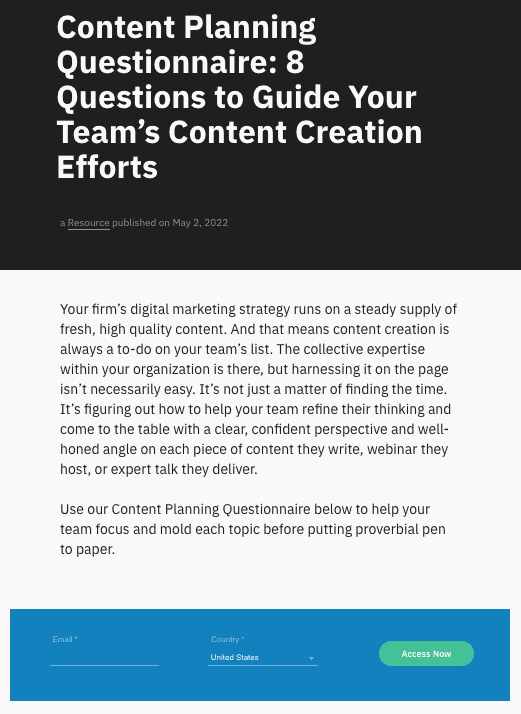What is the biggest impediment to any company’s content marketing success? Time.
Content marketing is hard work, folks. It takes a surprising amount of time and effort to focus your positioning; identify your target audiences; develop an editorial plan; create content; promote it via email, paid, and social; measure what’s working and what isn’t; and optimize. Phew. Wash, rinse, repeat. It’s — a lot.
So how do you lighten the marketing load on you and your team?
This is when this article starts sounding like those social media ads — rock hard abs in 6 minutes! Earn six figures while doing absolutely nothing! Buy a city in Italy for $1!
What if there is a relatively simple and quick way to boost valuable conversions on your site? But wait, there’s more!
What if all you had to do was reuse something you have already created?
Readers, meet your new best friend with an incredibly unsexy name: resource page. Resource pages are a way to further highlight content upgrades that you have already created.
What Is a Resource Page?
For the purposes of this article, a resource page is a web page on your site that highlights any online resource or tool you have created (a checklist, a calculator, a visual guide, etc.) and contains three elements:
- An H1 title
- A short abstract that describes the resource you are promoting
- A valuable online resource or tool behind a content gate
For example:

Because content upgrades are gated, educational assets that are usually embedded within a blog article, their entry points tend to be limited. While they provide great value to the readers of that blog article, they rely on prospects investing time to reach the upgrade.
With resource pages, the gated assets themselves become the primary draw — giving your resources the opportunity they deserve to attract prospective readers.
What Is the Ultimate Goal of a Resource Page?
Conversions. Conversions. Conversions. While your long-form blog posts are trust-building content that serve as your organic traffic engine, your conversions tell you who specifically is knocking on your front door.
Knowing your audience is key because in a battle between the most traffic and the right traffic, the latter always wins.
Resource pages are designed to attract prospects who want to peek into your toolbox and maybe even borrow something to solve their problems. And if you’re there at the right time with the exact right tool to solve their problem, there’s a high likelihood that they’re going to come back next time they need help. They may just hire you to solve it for them, too.
Here’s How You Create a Resource Page That Works
Be Brief
Resource pages are about clarity and ease of access to increase conversions. Keep your abstract under 200 words. This small group of words is meant to serve the same purpose as your white paper and eBook abstracts — to tell the prospect just enough to get them to convert.
If it only takes 50 words to pique a prospect’s interest about an ROI calculator, don’t write one word more. Let the complexity of the resource drive your character count.
Be Specific
Now is not the time to show off your MFA and bury the lede in subtext. Is your resource a questionnaire that helps prospects determine whether or not they should outsource their bookkeeping? Then your H1 title is:
“Download This Self-Assessment to Determine if Financial Outsourcing is Right For You”
This is the time to be direct, brief, and clear as a bell about your offering. Attention spans are short, and we are selling tools here, not pushing a three-year engagement with your firm.
Be Compelling
“Here’s a Checklist to Help With Your Marketing” is not compelling. These resources need to solve an actual, specific pain point for your prospects. Vague offers will get you nowhere.
Here’s a simple formula: X tool does Y thing and solves Z problem.
These tools could provide solutions as simple as time savings and complex as calculating the lifetime value of a new member in your affiliate program. The key takeaway for your prospects should be this: If this company freely gave me an online tool and solved my problem, I wonder how successful I could be if I hired them?
And that leads us into the next and possibly most important element of a successful resource page.
Be Bold
The long road to landing new business is littered with half-hearted pitches that partially obscure a firm’s real value position for fear of “giving away the farm.” These tools must provide true value to your prospects. And that value lies in imparting real wisdom and industry insight.
If a prospect could convert on a resource page, use your tool, and replicate the success of your firm, you have bigger problems than increasing your conversion rate.
Let prospects in on your shortcuts, secrets, and solutions. In turn, they will be compelled to repay you with new business at the end of that road.
The Extra Value Resource Pages Bring to Your Website
A well-constructed and designed website is part of your sales team. It is often the first impression a prospect gets of your business and your service offerings. A sophisticated prospect expects to be greeted with a positioning statement, service pages, case studies, capabilities pages, an insights page, and perhaps some company bios.
That same prospect would see that you really have your act together if you offer long-form blogs, videos, webinars, and eBooks or white papers as part of your insights page. This shows you have put in the effort to meet all types of prospects where they are in their buyer journey.
A resources section on your site is extra credit. What it says to your prospects is, “Don’t have time to read long-form thought leadership today? Here are some bite-sized resources that will solve your pain points right this moment.”
The power of conveying to your prospects that you have anticipated their needs (and respected their time) can not be overstated.
Resource Pages Are an Essential Part of Any Good Marketing Strategy
Resource pages save you time, honor your sophisticated prospects, and, quite frankly, make you look smarter. Slate the creation of these gems into your editorial calendar when you have especially busy months or need to focus on conversions rather than increased organic traffic.
Then what do you do? You sit back in your $1 Italian villa, admire your six-pack, and count your millions as new conversions roll in.
